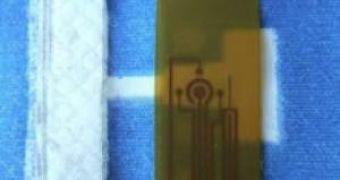They haven't yet entered the market, but the smart textiles are continuously improving, going beyond measuring body temperature and heart activity, which may seem obsolete now. New mini-biosensors integrated in the fabrics can analyze body fluids, like a drop of sweat, delivering more information on the wearer's health. When the data reveals warning signs, the garment will inform your doctor via a text message. The new textiles are developed by SFIT Group.
"The patch is a sensing and processing unit, adaptable to target different body fluids and biochemical species. At the very least, some basic biochemical analyses could complement the physiological measurements that can already be monitored. In some circumstances, fluidic analysis may be the only way to get information on a patient's health status," Jean Luprano, a researcher at the Swiss Center for Electronics and Microtechnology (CSEM) and coordinator of the BIOTEX project, told Science Daily.
But the trick with this technology is collecting fluids and directing them to the biosensing units.
The new technology
The BIOTEX partners (teams from Italy, France and Ireland) have collaborated with CSEM, developing an array of prototype ionic biosensors, assessing sodium, potassium and chloride levels in sweat samples. Another device measures the conductivity of sweat and a pH mini-sensor determines the acidity of the sweat based on color changes. An immunosensor, easy to insert into wound dressings or bandages, can track down the presence of specific proteins in fluids.
"These biosensors are not just scaled-down versions of existing technology. Many of the chemical or biochemical reactions used in sample assays are non-reversible and some part of the biosensor has to be replaced. When you monitor continuously you can't do that - you need a sensor that binds your substrate reversibly. Also, the BIOTEX sensors work on tiny volumes of liquid, so we had to come up with innovative designs and materials that would make it possible to miniaturize the sensors and make them compatible with fabrics," said Luprano.
The pH sensor and the immunosensor use optical measurements. Plastic optical fibers (POFs) are integrated into the fabric, providing light to the optical sensors and reflected light to the spectrometer.
The BIOTEX oxygen probe detects the oxygen levels in the blood around the thorax based on reflective oximetry. A cluster of POFs lights a large part of the thorax and the oximeter sensor measures the reflected red and infrared light.
"The volume of fluid secreted from sweat glands is just a few millilitres over a small surface and the body's heat means this is rapidly vaporised. We needed some kind of pump that could collect sweat in one area and bring it to the sensor array, where it could be channeled through each sensor," said Luprano.
That's why the textile is made of hydrophilic (water-loving) and hydrophobic (water-repellent) threads. These are woven so that they channel the sweat towards the sensors. Because this is a passive system which does not consume power, the battery required by BIOTEX will remain smaller. The BIOTEX textiles will be tested on patients with obesity and diabetes, but also sportsmen, before turning available for the ordinary consumers.
SFIT is also working at a project called PROETEX, aiming to integrate this mini-technology in specific applications (like fire fighting and rescue teams).

 14 DAY TRIAL //
14 DAY TRIAL //